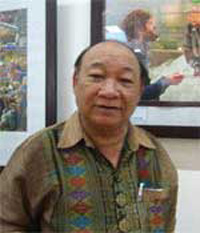Shooting the right people at the right time Hoang Kim Dang has shot his way into the nation's history books with iconic photographs of leading lights like General Vo Nguyen Giap and writer Nguyen Tuan. Watch their hands, he tells Nguyet Ha as he reflects on his career and shares insightful tips about sketching photographic portraits of famous people.
During the funeral ceremony of General Vo Nguyen Giap last October, many people held his portraits to pay homage to the national hero. One of the photos showed Gen Giap smiling radiantly and waving his hands as if he was saying farewell to his beloved compatriots. Not many people know that this precious 20-year-old photo was taken by photographer Hoang Kim Dang. How did you take that portrait of Gen Vo Nguyen Giap? I met Gen Giap five times. His spirit and modest style impressed me profoundly right on the first meeting. In 1991, when he turned 80, he invited me and another photographer, Nguyen Nhung, to his house to take his portrait photos, saying honestly and humorously that he wanted a photo to put in front of a [funeral] car. Nhung only smiled, while I said that he would not need such a photo for the next 20 years! In fact, Gen Giap needed a photo to return the affection that his compatriots and foreign friends had for him. In the last few years, Gen Giap visited over 10 countries which supported At the photo session, he agreed with my idea and put on his uniform, pinned on his badges and waved his hand so that I could take his portrait. After that meeting, I gave him several small photos of him. It was not until 1999 that I printed a large photo mounted on wood to gift him, along with another photo of him inspecting the battlefield. He said nothing about the small photo, but on seeing the large photo, he said with a smile: "The portrait is very interesting. If anything happens, this portrait will be my farewell to everybody, to my compatriots and my country…" According to people close to Giap, he became more and more interested in the photo over time. During Gen Giap's funeral, your photo was published in national and local newspapers and was shared widely on the internet. However, few gave credit to the photographer. How did you feel at that time? During his funeral ceremony, I stood among the groups of people in front of the Ha Noi Opera House to show my deep respect and bid him farewell. There were many children holding the photo that I had taken of Gen Giap. It made me feel very happy and proud that my work was very valuable on such a special day. People from both the north and south of It is said that while you were working for Van Nghe (Letters and Arts) newspaper, you had many opportunities to meet and take portraits of renowned Vietnamese writers and poets like Nguyen Tuan (1910-87) or That's right. I'm interested in writer Nguyen Tuan's style very much. Therefore, I was very curious to discover his personality and literature. I have read most of his works. Nguyen Tuan was a strong-willed and sometimes stubborn man - even in a negative way - who hated flattery. However, at that time, I dared not take his photo. Then I tried to take the photo of poet Why do you always pay attention to the context of the portraits? I think that a genuine portrait requires a thorough understanding of the characters and contexts in which they can reveal their personalities, emotions and feelings. Besides the eyes, mouth and facial expressions, I always pay special attention to the hands: they can be shown to be clapping for giving congratulations, or raised high to express struggle, and held together to portray flattery. Without hands, a personality cannot be fully expressed in a portrait shot. Photography is like literature. If the photographer takes only photos and describes facts the way they are, his work can only be called a note instead of a short story or fiction. Source: VNS/VNN |
↧
Article 1
↧
